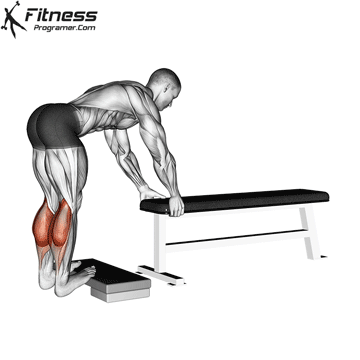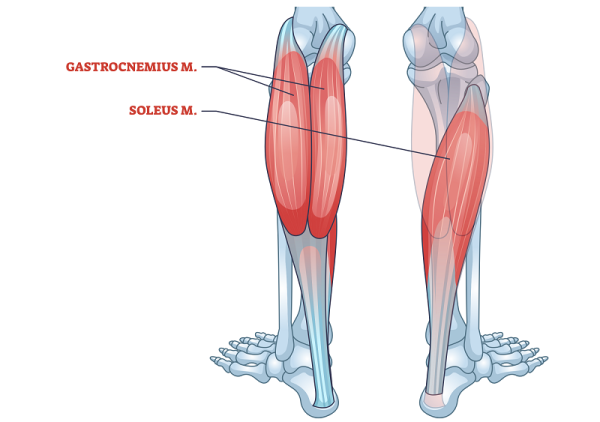Overview
The donkey calf raise is a unique and highly effective calf isolation exercise that emphasizes the gastrocnemius through deep stretching and strong peak contractions. Unlike seated or standing calf raises, the donkey variation uses a hip-hinged torso position, which places the knees in full extension while the upper body is bent forward, shifting the center of gravity and increasing the stretch at the bottom of the movement.
Originally popularized by Golden Era bodybuilders like Arnold Schwarzenegger, the donkey calf raise remains a gold standard for calf development, particularly for those seeking enhanced range of motion, targeted overload, and serious size gains.
How to Perform the Donkey Calf Raise

Foot Position: Stand with the balls of your feet on a raised edge or block, heels hanging off. Toes should point straight or slightly outward.
Torso Alignment: Hinge forward at the hips to roughly 90°, keeping your spine neutral. Hold the handgrips or support surface to stabilize.
Start in a Deep Stretch: Allow your heels to descend slowly until you feel a full stretch in your calves.
Lift Up: Drive through the balls of your feet to raise your heels as high as possible, keeping knees extended.
Contract and Hold: Pause at the top for 1–2 seconds, squeezing the calves forcefully.
Lower Under Control: Slowly lower your heels back into the stretched position.
Repeat: Perform the desired number of reps while maintaining strict control and posture.
Tips for Proper Form
Maintain a hip-hinged position with a flat back throughout the movement.
Avoid knee bending, as this shifts tension away from the gastrocnemius and onto the soleus.
Use a full range of motion, emphasizing both the deep stretch and full contraction.
Squeeze at the top, rather than bouncing through reps.
Hold the support handles lightly—they are for stability, not for pulling yourself upward.
Common Mistakes to Avoid
Rushing the movement, which minimizes eccentric loading and stretch tension.
Bending the knees, which decreases gastrocnemius activation and limits range.
Relying on momentum, especially at the bottom, increasing risk to the Achilles tendon.
Allowing the upper body to round, reducing spinal alignment and load safety.
Misaligned foot placement, which can strain the ankles and reduce calf engagement.
Benefits of the Donkey Calf Raise
Maximizes gastrocnemius stretch and load, improving muscle fiber recruitment.
Allows for greater range of motion than standing or seated variations.
Highly scalable, whether using bodyweight, partner load, or machine.
Improves ankle joint mobility and power output for running and jumping.
Enhances mind-muscle connection, especially when performed slowly.
Addresses strength and symmetry imbalances, particularly in bilateral training.
Improves Achilles tendon strength and resilience under eccentric load.
How to Incorporate Into Your Routine
For Beginners: Use bodyweight only or a light machine setting, focusing on slow control—2–3 sets of 10–12 reps.
For Hypertrophy: Load with a partner, machine, or dip belt with weights, performing 3–5 sets of 12–15 slow reps with full ROM.
For Strength: Use heavier resistance on a machine and perform 4 sets of 8–10 controlled reps, pausing at both ends.
For Functional Training: Integrate as part of a lower-body posterior chain accessory circuit for full-length ankle flexion strength.
For General Fitness: Perform weekly to maintain mobility and strength in the ankle joint and posterior leg.
For Sports Performance: Use post-sprint or plyometric sessions to restore gastrocnemius length and contractile quality.
Donkey Calf Raise: Muscles Worked

Frequently Asked Questions
Why use the donkey position instead of standing upright?
The forward-leaning torso increases the gastrocnemius stretch and limits compensatory movement, allowing for a deeper and more isolated contraction.
Can I do this at home without a machine?
Yes. You can use a dip belt with weights while leaning on a bench, or have a partner gently sit on your hips/lower back. Ensure stability and safety when improvising.
Is this better than the standing or seated calf raise?
It’s not “better,” but it complements both. Donkey calf raises emphasize stretch and peak contraction, especially for gastrocnemius growth, while seated calf raises better target the soleus.
How often should I do donkey calf raises?
2–3 times per week is sufficient for most lifters, with volume tailored to hypertrophy or endurance goals.
Why do I feel this more in one leg than the other?
Imbalances in ankle mobility, foot pressure, or torso lean can shift load unevenly. Perform single-leg donkey variations or address hip/pelvic imbalances to fix this.
